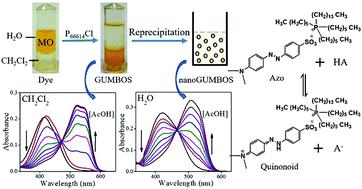Fabrication of a GUMBOS-based acid–base indicator: smart probe for sensing acids and bases in any solvent†
Abstract
This report outlines the synthesis of an ionic liquid-based pH-responsive indicator to sense acids or bases in non-polar as well as polar solvents. Herein, we have assembled a new ionic liquid (IL) comprised of a group of uniform materials based on organic salts (GUMBOS) by attaching a quaternary phosphonium ionic liquid with a very common acid–base indicator, methyl orange, via simple ion-exchange reaction. This integrated IL-based indicator is highly soluble in less polar solvents and exhibits good sensitivity toward the presence of acids/bases in those media. Furthermore, this indicator has been exploited in determining the dissociation constants of several acids in non-aqueous aprotic solvents by overlapping indicator method and hence this report provides essential information toward the understanding of many fundamental chemical reactions. This report has further scope for the synthesis of novel aqueous suspended nanomaterials, i.e., the nanoparticles derived from GUMBOS (nanoGUMBOS) by a simple flash nano-precipitation method. The nanomaterial has been well characterized by different spectroscopic and microscopic studies. The obtained nanoparticles also exhibit substantial pH-responsive behaviors in aqueous medium and show better susceptibility as compared to the free organic indicator. Thus, this report explores detailed studies on the IL-based indicator in sensing the acidity/basicity of various media.



 Please wait while we load your content...
Please wait while we load your content...